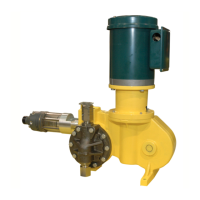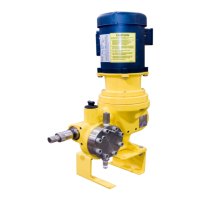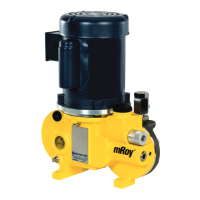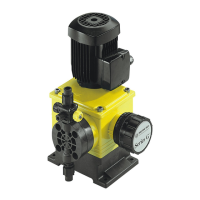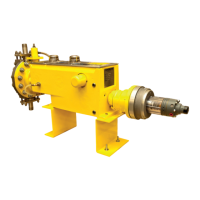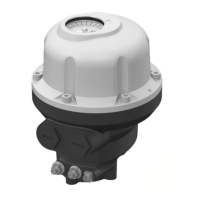GM003GB
PART III - START UP
III - 1. PROCEDURES BEFORE
START UP
Special care has to be taken for chemicals used in the
process (acids, bases, oxiding/reducing solutions, ...).
See Figure 1.2a.
• Check that the pump is secured to its support
(Chapter II - 4. Setting up).
• Check the pipe fitting torque.
• Check the opening of all the isolating valves
installed on the suction and discharge circuits. If
your pump is equipped with a 4-function valve, see
the relevant specific documentation. If the discharge
circuit is equipped with an injection nozzle or a
back-pressure valve, open the priming valve on the
discharge side (if there is no priming valve,
disconnect the piping on the discharge side). This
allows you to check for the presence of liquid if the
pump is installed in flooded suction or to prime the
pump if it is installed in suction lift.
• Set the pump capacity adjustment to 0% (stroke
adjustment knob [4]).
Checking the electrical connection of the
motor
Start up the pump to check the motor's direction of
rotation. It must comply with that indicated by the arrow
marked on the pump cover.
To reverse the motor's direction of rotation, invert A
and (See Figure 2.5b or 2.5c).
III - 2. START UP
• Once all the checks and procedures described in
the previous section have been carried out, start up
the pump.
• Check visually and by listening. (In particular, check
that there are no suspicious noises).
• Make sure that the stroke adjustment knob is
unlocked.
• Adjust the pump capacity gradually from 0 % to 100
% and control
- either the liquid output at priming valve,
- either the noise of the liquid when it goes
through the discharge check valve (if
your installation is not equipped withe a
priming valve).
Priming has been achieved if one of the two conditions
is carried out. Close the priming valve.
• Set the pump to the desired capacity. Lock the
stroke adjustment knob.
III - 3. FAILURES ON START UP
PROBLEMS WITH MOTOR
The motor runs with difficulty and heats up.
• The characteristics of the electrical power supply do
not match the specifications of the motor.
• One phase is incorrectly connected.
• The electrical connection used is not
suitable.
• Check that the pressure on the discharge side is
compatible with the equipment’s capabilities.
• Too many flow pulsations : a pulsation dampener is
required, or the pulsation dampener installed is of
the wrong size, or the pressurization of the pulsation
dampener is incorrect.
• The direction of rotation of the motor is
incorrect. (Check using the arrow marked
on the cover). Reverse the direction of
rotation (see Chapter III - 1. Procedures
before start up, Checking the electrical
connection of motor).
PROBLEMS WITH FLOW RATE
The flow rate is lower than desired
• The pump capacity is incorrectly adjusted: adjust
the capacity to the desired value and lock the stroke
adjustment knob.
• The suction power is insufficient. (Piping cross-
section too small or piping too long): replace the
pipes with ones with a larger cross-section or install
the pump in flooded suction.
• The leak-tightness of the suction pipes is
unsatisfactory.
• The viscosity of the liquid is incompatible with the
capabilities offered by your pump version.
The capacity is greater than desired
• The pump capacity is incorrectly adjusted: adjust
the capacity to the desired value and lock the stroke
adjustment knob.
• A syphoning phenomenon is observed: check that
the suction pressure is not greater than the
discharge pressure. Install a back-pressure valve on
the discharge side.
• Too many flow pulsations : a pulsation dampener is
required, or the pulsation dampener installed is of
the wrong size, or the pressurization of the pulsation
dampener is incorrect.
The capacity is variable
• This problem may be due to particles from the
piping which interfere with the operation of the valve
assemblies: clean the piping and the valve
assemblies
Tri
Tri
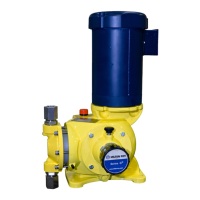
